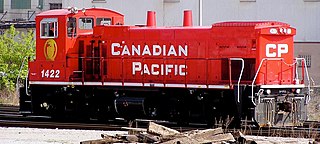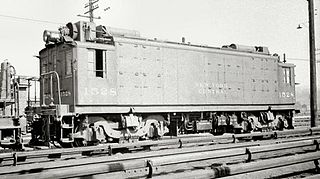
A diesel locomotive is a type of railway locomotive in which the power source is a diesel engine. Several types of diesel locomotives have been developed, differing mainly in the means by which mechanical power is conveyed to the driving wheels. The most common are diesel-electric locomotives and diesel-hydraulic.

Baldwin Locomotive Works (BLW) was an American manufacturer of railway locomotives from 1825 to 1951. Originally located in Philadelphia, Pennsylvania, it moved to nearby Eddystone in the early 20th century. The company was for decades the world's largest producer of steam locomotives, but struggled to compete when demand switched to diesel locomotives. Baldwin produced the last of its 70,000-plus locomotives in 1951, before merging with the Lima-Hamilton Corporation on September 11, 1951, to form the Baldwin-Lima-Hamilton Corporation.

Montreal Locomotive Works (MLW) was a Canadian railway locomotive manufacturer which existed under several names from 1883 to 1985, producing both steam and diesel locomotives. For a number of years it was a subsidiary of the American Locomotive Company. MLW's headquarters and manufacturing facilities were in Montreal, Quebec.

The E9 is a 2,400-horsepower (1,790 kW), A1A-A1A passenger train-hauling diesel locomotive built by General Motors' Electro-Motive Division of La Grange, Illinois, between April 1954 and January 1964. 100 cab-equipped A units were produced and 44 cabless booster B units, all for service in the United States. The E9 was the tenth and last model of EMD E-unit and differed from the earlier E8 as built only by the newer engines and a different, flusher-fitting mounting for the headlight glass, the latter being the only visible difference. Since some E8s were fitted with this, it is not a reliable way to distinguish the two. The E9 has two 1,200 hp (895 kW), V12 model 567C engines, each engine driving one generator to power two traction motors.
Early Electro-Motive Corporation switcher locomotives were built with Winton 201-A engines. A total of 175 were built between February 1935 and January 1939. Two main series of locomotives were built, distinguished by engine size and output: the straight-8, 600 hp (450 kW) 'S' series, and the V12, 900 hp (670 kW) 'N' series. Both were offered with either one-piece cast underframes from General Steel Castings of Granite City, Illinois, denoted by 'C' after the power identifier, and fabricated, welded underframes built by EMC themselves, denoted by 'W'. This gave four model series: SC, SW, NC and NW. Further developments of the 900 hp (670 kW) models gave model numbers NC1, NC2, NW1, and NW1A, all of which were practically indistinguishable externally from the others, as well as a pair of unique NW4 models for the Missouri Pacific Railroad and a solitary, twin-engined T transfer locomotive model built for the Illinois Central Railroad.

Electro-Motive Diesel is a brand of diesel-electric locomotives, locomotive products and diesel engines for the rail industry. Formerly a division of General Motors, EMD is now owned by Progress Rail, a subsidiary of Caterpillar Inc. Electro-Motive Diesel traces its roots to the Electro-Motive Engineering Corporation, founded in 1922 and purchased by General Motors in 1930. After purchase by GM, the company was known as GM's Electro-Motive Division. In 2005, GM sold EMD to Greenbriar Equity Group and Berkshire Partners, and in 2010, EMD was sold to Progress Rail. Upon the 2005 sale, the company was renamed to Electro-Motive Diesel.

The EMD MP15AC is a 1,500 hp (1,120 kW) diesel road switcher locomotive built by General Motors' Electro-Motive Division between August 1975 and August 1984. A variant of the EMD MP15DC with an AC/DC transmission, 246 examples were built, including 25 for export to Mexico, and four built in Canada.

An electro-diesel locomotive is a type of locomotive that can be powered either from an electricity supply or by using the onboard diesel engine. For the most part, these locomotives are built to serve regional, niche markets with a very specific purpose.

The ALCO RS-2 is a 1,500–1,600 horsepower (1,100–1,200 kW) B-B diesel-electric locomotive built by the American Locomotive Company (ALCO) from 1946 to 1950. ALCO introduced the model after World War II as an improvement on the ALCO RS-1. Between 1946 and 1950, 377 examples of the RS-2 were built, primarily for American and Canadian customers.
Pennsylvania Railroad class E2c comprised a pair of experimental C-C (AAR) or Co-Co (UIC) electric locomotives. The bodywork and running gear was produced by Baldwin-Lima-Hamilton while the electrical equipment was provided by Westinghouse, who also acted as principal contractor.

The Milwaukee Road's class EP-3 comprised ten electric locomotives built in 1919 by Baldwin and Westinghouse. They were nicknamed Quills because of their use of a quill drive. Although they were good haulers and well liked by engineers, poor design and constant mechanical problems plagued them for their entire lives and they were among the first of the Milwaukee Road's electric locomotives to be retired.

Steeplecab is railroad terminology for a style or design of electric locomotive; the term is rarely if ever used for other forms of power. The name originated in North America and has been used in Britain as well.

The GE 45-ton switcher is a 4-axle diesel locomotive built by General Electric between 1940 and 1956.

Delta Valley and Southern 50 is a standard gauge diesel-electric locomotive built by General Electric in May, 1954, GE #32129 for the Delta Valley and Southern Railway. It replaced a small steam locomotive. It is of the type designated as a 45-ton, although the actual weight may be different from that. It is powered by two Cummins HBI-600 six-cylinder diesel prime movers, each of which drives a generator which, in turn, drives a single electric traction motor, one on each truck. The second axle on each truck is driven by a side rod.

The GE three-power boxcabs were early electro-diesel hybrid switcher locomotives. These boxcabs were termed oil battery electrics to avoid the use of the German name Diesel, unpopular after World War I.

Baldwin, the locomotive manufacturer, and Westinghouse, the promoter of AC electrification, joined forces in 1895 to develop AC railway electrification. Soon after the turn of the century, they marketed a single-phase high-voltage system to railroads. From 1904 to 1905 they supplied locomotives carrying a joint builder's plate to a number of American railroads, particularly for the New Haven line from New York to New Haven, and other New Haven lines. Westinghouse would produce the motors, controls, and other electrical gear, while Baldwin would produce the running gear, frame, body, and perform final assembly.

The New Haven EP-2 was a class of boxcab electric locomotives built by Baldwin-Westinghouse for the New York, New Haven and Hartford Railroad. The locomotives worked passenger trains on the New Haven's electrified division west of New Haven, Connecticut. Baldwin-Westinghouse delivered 27 locomotives between 1919–1927. The locomotives were an enlarged version of the EP-1 and EF-1 designs. They remained in service until the arrival of the dual-mode EMD FL9 locomotives in 1958.

The Great Northern Z-1 was a class of ten electric locomotives built for the Great Northern Railway They were used to work the route through the second Cascade Tunnel. They were built between 1926–1928 by Baldwin Locomotive Works, with Westinghouse electrics, and stayed in service until dieselisation in 1956. Each was of 1,830 horsepower (1,360 kW) with a 1-D-1 wheel arrangement, although they were always used in coupled pairs.


























